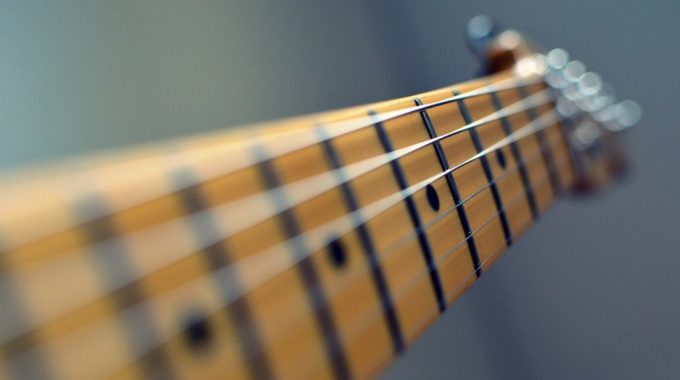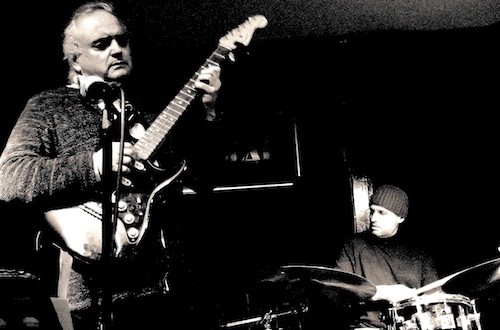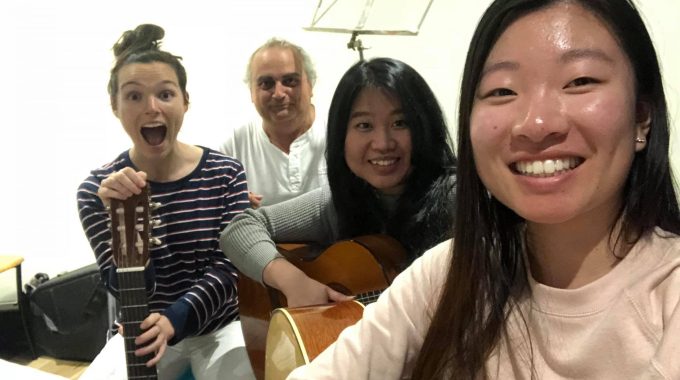Why sing before you play? Why do we learn chords on the guitar?How to create strumming patterns?....

Lesson 1 – How to find notes on the guitar fretboard
This is the transcript of lesson 1 of the Beginners Guitar Course. Please follow this link for next available starting times.
What are you going to learn?
To identify by sound and name the notes of C scale, on all strings and frets on the guitar.
You will also learn a song, a rhyme that you will sing and play, to teach you how to anticipate aurally and visually, the next note of the scale you wish to play.
You will also learn to think in a musical way so as to emulate what goes through the mind of the professionals, when we play. This will drastically increase the speed and fun of your learning, on how to find notes on the guitar.
Why learn how to find notes on the guitar?
So you can locate visually and by sound, the scales, chords and melodies we will use in our course.
What will you do differently after this lesson?
You will be able to create musical phrases of four beats duration, which are one of the basic building blocks of music. As a consequence, this will open up a pathway for your learning that simulates the real thing.
You will be able to coordinate your left and right hand to play the C scale in tempo, all over the guitar to help you in your how to find notes on the guitar.
And you will be able to look for sounds horizontally or vertically, as on the guitar, pitch can increase vertically, decrease vertically, or increase horizontally, or decrease horizontally.
How are you going to learn to find notes on the guitar?
You will learn to find notes on the guitar in four simple steps:
- First of all, you will learn the names of the strings, that correspond to pitches, musical sounds.
- Then you will learn the relationship between the pitches of the C scale, and the frets on the guitar.
- In step 3, you will learn a melodic rhyme to help you find all the notes in relation to a beat.
- In step 4, you will create your own practice routine, to develop the skill with fun.
Rules
Apply at all times when you play the following 3 rules:
- Always sing what you are playing.
- Always play in tempo.
- Always tap your feet or move your body to the beat.
If you do not, you will not be feeling the context, the music, therefore you will not learn.
Names of the strings
The guitar has 6 strings: E A D G B E. Each string is adjusted to produce a specific pitch, a musical sound we can sing. These pitches have defined names. In English, we use the letters of the alphabet C D E F G A B to define them.
The fatter guitar string produces the lowest pitch. As we jump from string to string, the strings get thinner, they also vibrate more quickly and the sound increases in pitch.
The fatter string is tuned to a frequency we call E. It is commonly called the E string but please remember that this is relative, as this can change, this is not an E string but a string tightened until it produces this pitch, we call E .
So if I press the string somewhere else, do I produce a new sound? Yes.
Is this new sound an E?
No . It is not since it does not sound like an E. It sounds higher in pitch. There fore it has a different name. It is called the G note.
So what frequencies do we generally tune the open guitar strings to?
Starting from fat to thin they coincide with the frequencies of :
E
A
D
G
B
E
Acronym
You can remember the names of the pitches, frequencies of the strings, by using an acronym. I like to use the following:
E very to remember the name of the E string
A pe to remember the name of the A string
D eserves to remember the name of the D string
G reen to remember the name of the G string
B ananas to remember the name of the B string
E veryday ( to remember the name of the high E string
Play along with me this acronym
Every, Ape, Deserves, Green, Bananas, Everyday
Stop the video, rewind and repeat this exercise as many times as you need to.
Step 2 Find the notes of C scale
Take it easy
All musicians including myself, struggle with new exercises. This is absolutely normal. However, music is a discipline where you learn by repetition. Do not expect to fully understand the following new concepts until you have repeated the exercises, a lot. So, just sit back and enjoy the ride and in a few minutes time you will have learnt the C scale all over the guitar.
The C scale has seven notes
The C scale has seven notes: C D E F G A B . After the B we go to C D E F and so on.
So this is a low c and this is a high c. The high C doubles the frequency of the low C. The frequency is the number of times the string vibrates per second.
Therefore, as I go up in pitch, I start to repeat the same notes, but in a higher octave, a higher pitch,
Frets and notes
In order to answer how to find notes on the guitar, all you need to understand is that between the notes of E F, and B C there is only one fret distance and between all the other notes there are two.

This is one fret distance. This is two frets distance.
So let us start with the sixth string.
What is the frequency we tune the 6th string to ….. E ? So this is an E sound.
Play the note
Sing the sound
What is the next letter in the alphabet ?
F
How many frets is F away from E?
One
Play the F
Sing the sound
So F is a musical note that is higher in pitch than E, and we produce the sound by shortening the string by one fret.
Next note
What is the next letter in the alphabet after F?
G
How many frets is G away from F?
Two
Play the G
Sing the sound
So G is a musical note that is higher in pitch than F, and we produce the sound by shortening the string two more frets.
Next note
The next letter in the alphabet is:
A
How many frets is it away from G ?
Two
Play the A
Sing the A
So A is a musical note that is higher in pitch than G, and we produce the sound by shortening the string two more frets.
Next note B
The next letter in the alphabet is:
B
How many frets is it away from A?
Two
Play the B
Sing the B
So B is a musical note that is higher in pitch than A, and we produce the sound by shortening the string two more frets.
Next note C
The next letter in the alphabet is:
C
How many frets is C away from B?
One
Play the C
Sing the C
So C is a musical note that is higher in pitch than B, and we produce the sound by shortening the string one more fret.
Next note D
The next letter in the alphabet is:
D
How many frets is D away from C?
Play it
Sing it
So D is a musical note that is higher in pitch than C, and we produce the sound by shortening the string two more frets.
Next note E
The next letter in the alphabet is:
E, So we are back to the E , but a higher E.
How many frets is E away from D?
2
Play it
Sing it
So E is a musical note that is higher in pitch than D, and we produce the sound by shortening the string by two more frets.
Step 3 The Musical Rhyme
You will now learn a short musical rhyme to play in tempo the notes of the C scale, in a manner that will help you memorise both names and sounds and increase the speed of your learning drastically and therefore learn how to find notes on the guitar.
The C scale on the 6th string
Notice: that I sing the sound of the note I play, and then sing what I will do next with the same sound,
Also notice that the rhyme lasts 4 beats, four taps of your foot.
Play along with me, 6th string
Let´s play together the rhyme on the 6th string.
Play along with me
Stop the video , rewind and repeat this exercise as many times as you need to.
Play along with me, 5th string
Let´s play together the rhyme on the 5th string.
What is the frequency we tune the 5th string to ….. A ?
So this is an A sound.
Play it
Sing it
Play along with me
Stop the video, rewind and repeat this exercise as many times as you need to.
Play along with me, 4th string
Let´s play together the rhyme on the 4th string.
What is the frequency we tune the 4th string to ….. D ?
So this is a D sound
Play it
Sing it
Play along with me
Stop the video, rewind and repeat this exercise as many times as you need to.
Play along with me, 3rd string
Let´s play together the rhyme on the 3rd string.
What is the frequency we tune the 3rd string to ?
So this is a G sound.
Play it
Sing it
Play along with me
Stop the video, rewind and repeat this exercise as many times as you need to.
Play along with me, 2nd string
Let´s play together the rhyme on the 2nd string.
What is the frequency we tune the 2nd string to …? B
So this is a B sound.
Play it
Sing it
Play along with me
Stop the video, rewind and repeat this exercise as many times as you need to.
Play along with me, 1st string
Let´s play together the rhyme on the 1st string.
What is the frequency we tune the 1st string to …? E
So this is an E sound.
This is also an E sound, but this E is higher and this E is lower in pitch.
This low E vibrates exactly four times slower than this E. They are the same notes, but in different octaves.
Play it
Sing it
Play along with me
Stop the video, rewind and repeat this exercise as many times as you need to.
Assignments
Now it is time for you to complete the assignments for this lesson on how to find notes on the guitar.
- Play along
Repeat twice a day all the play along examples of lesson one.
- Fill it in
Fill in the blank sheet with all the notes of the C scale .
- Quiz
Please submit your replies to our group for peer review.
- Why are there different Cs on the guitar ?
- Why are there different As on the guitar?
- Why do we have two strings tuned to E?
- Indicate with an X on what two other strings and positions can you play the C note, you create on the B string when you press the second fret.
- Record and create
Record yourself singing the rhyme, non stop on 6 different strings and send it to me.
Note: Choose a very slow tempo
Check questions
- Are you singing the notes in exact relation to the beat?
- Are you tapping your foot non stop while singing and playing?
- Are you moving to the new note only just before you sing it?
- If your answer is no to any of the these questions, repeat 4 more times all the play along examples.
What will you be able to do at the end of the course?
Students that complete the two beginners course will move on directly to Guitar for songwriters focused towards music production.


